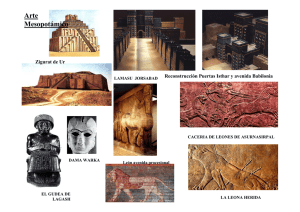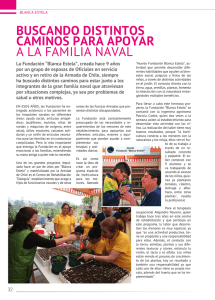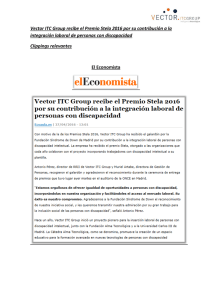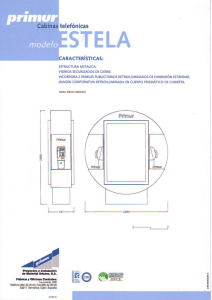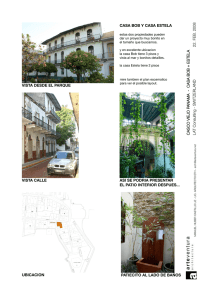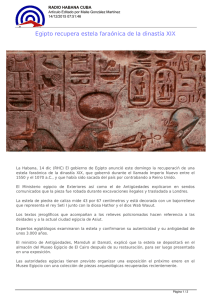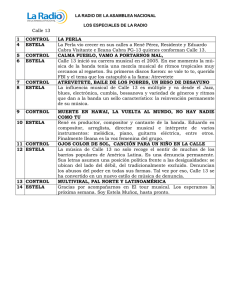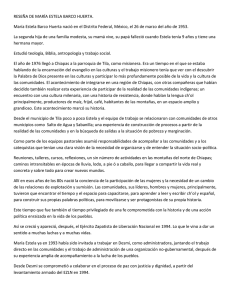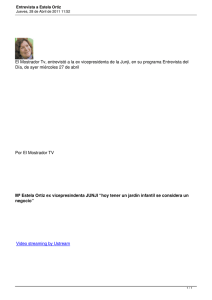Manual de los Monumentos de Copán, Honduras
Anuncio
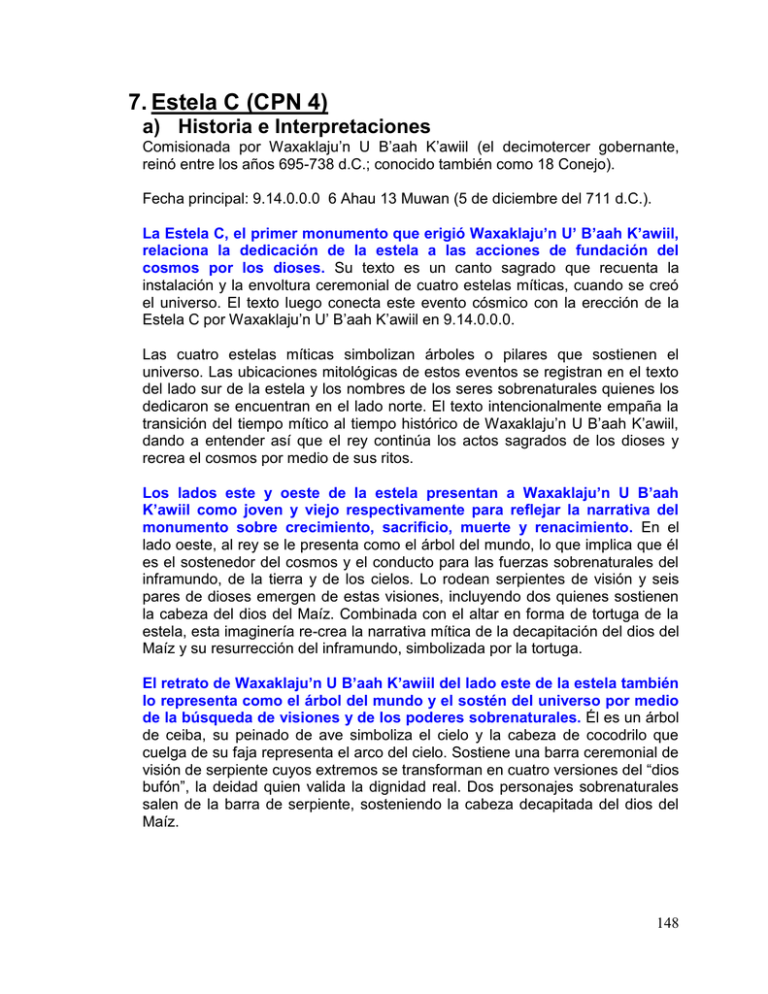
7. Estela C (CPN 4) a) Historia e Interpretaciones Comisionada por Waxaklaju‘n U B‘aah K‘awiil (el decimotercer gobernante, reinó entre los años 695-738 d.C.; conocido también como 18 Conejo). Fecha principal: 9.14.0.0.0 6 Ahau 13 Muwan (5 de diciembre del 711 d.C.). La Estela C, el primer monumento que erigió Waxaklaju’n U’ B’aah K’awiil, relaciona la dedicación de la estela a las acciones de fundación del cosmos por los dioses. Su texto es un canto sagrado que recuenta la instalación y la envoltura ceremonial de cuatro estelas míticas, cuando se creó el universo. El texto luego conecta este evento cósmico con la erección de la Estela C por Waxaklaju‘n U‘ B‘aah K‘awiil en 9.14.0.0.0. Las cuatro estelas míticas simbolizan árboles o pilares que sostienen el universo. Las ubicaciones mitológicas de estos eventos se registran en el texto del lado sur de la estela y los nombres de los seres sobrenaturales quienes los dedicaron se encuentran en el lado norte. El texto intencionalmente empaña la transición del tiempo mítico al tiempo histórico de Waxaklaju‘n U B‘aah K‘awiil, dando a entender así que el rey continúa los actos sagrados de los dioses y recrea el cosmos por medio de sus ritos. Los lados este y oeste de la estela presentan a Waxaklaju’n U B’aah K’awiil como joven y viejo respectivamente para reflejar la narrativa del monumento sobre crecimiento, sacrificio, muerte y renacimiento. En el lado oeste, al rey se le presenta como el árbol del mundo, lo que implica que él es el sostenedor del cosmos y el conducto para las fuerzas sobrenaturales del inframundo, de la tierra y de los cielos. Lo rodean serpientes de visión y seis pares de dioses emergen de estas visiones, incluyendo dos quienes sostienen la cabeza del dios del Maíz. Combinada con el altar en forma de tortuga de la estela, esta imaginería re-crea la narrativa mítica de la decapitación del dios del Maíz y su resurrección del inframundo, simbolizada por la tortuga. El retrato de Waxaklaju’n U B’aah K’awiil del lado este de la estela también lo representa como el árbol del mundo y el sostén del universo por medio de la búsqueda de visiones y de los poderes sobrenaturales. Él es un árbol de ceiba, su peinado de ave simboliza el cielo y la cabeza de cocodrilo que cuelga de su faja representa el arco del cielo. Sostiene una barra ceremonial de visión de serpiente cuyos extremos se transforman en cuatro versiones del ―dios bufón‖, la deidad quien valida la dignidad real. Dos personajes sobrenaturales salen de la barra de serpiente, sosteniendo la cabeza decapitada del dios del Maíz. 148 7. Estela C (CPN 4) a) History and Interpretations Commissioned by Waxaklaju‘n U B'aah K'awiil (the 13 th ruler, reigned A.D. 695738; previously known as 18-Rabbit). Principal date: 9.14.0.0.0 6 Ahau 13 Muwan (5 December, A.D. 711). Stela C, the first monument erected by Waxaklahu’n U’ B’aah K’awiil, ties the stela’s dedication to the cosmos-founding acts by the gods. Its text is a sacred chant recounting the erection and ceremonial wrapping of four mythical stelae when the universe was created. The text then connects this cosmic event to the erection of Stela C by Waxaklaju‘n U B‘aah K‘awiil on 9.14.0.0.0. The four mythical stelae symbolize trees or pillars that support the universe. The mythical locations of these events are recorded in the text on the stela‘s south side, and the names the supernatural beings who dedicated them are found on the north side. The text intentionally blurs the transition from mythical time to the historical time of Waxaklaju‘n U B‘aah K‘awiil, thereby implying that the king continues the sacred acts of the gods and recreates the cosmos through his rituals. The east and west sides of the stela present Waxaklaju’n U B’aah K’awiil as young and old to reflect the monument’s narrative of growth, sacrifice and death, and rebirth. On the west side, the king is portrayed as the world tree, implying his being the sustainer of the cosmos and the conduit for the supernatural forces of the underworld, the earth and the heavens. He is surrounded by vision serpents, and six pairs of gods emerge from these visions, including two who hold the head of the Maize god. Combined with the stela‘s turtle effigy altar, this imagery re-creates the mythic narrative of the decapitation of the Maize god and his resurrection from the underworld symbolized by the turtle. The east side portrait of Waxaklaju’n U B’aah K’awiil also portrays him as the world tree and supporter of the universe through his vision quests and supernatural powers. He is a ceiba tree, his avian headdress symbolizes the sky, and the crocodile head hanging from his belt represents the arch of heaven. He holds a ceremonial vision serpent bar whose ends transform into four versions of the ―jester god‖ deity who sanctions kingship. Two supernaturals emerge from the serpent bar, holding the decapitated head of the Maize god. 149 b) Iconografía/Iconography Estela C, lado Este / Stela C, East side. Foto/ Photo: Ana Lucia Gastélum 150 Estela C, lado Este. Dibujo e identificación de algunos aspectos conográficos. Stela C, East side. Drawing and identification of some iconographic aspects. Dibujo/ Drawing: Barbara Fash 151 Estela C, lado Oeste / Stela C, West side. Foto/ Photo: Ana Lucia Gastélum 152 Estela C, lado Oeste. Dibujo e identificación de algunos aspectos iconográficos. Stela C, West side. Drawing and identification of some iconographic aspects. Dibujo/ Drawing: Barbara Fash 153 c) Escritura Jeroglífica/Hieroglyphic Writing Estela C, lado Sur / Stela C, South side. Foto/ Photo: Ana Lucia Gastélum 154 Estela C. Dibujo, lado Sur / Stela C. Drawing, South side. Dibujo/ Drawing: Linda Schele 155 Dibujo de los jeroglíficos de la Estela C, lado Sur, y su traducción aproximada / Drawing of Stela C hieroglyphs, South side, and their approximate translation. A ??-TUN (HAB') ??-haab' ?? year ¿? del año 13-TZUTZ?-??-6-AJAW huxlaju'n tzuutz? ?? wak ajaw 13 Tzuutz? ?? 6 Ajaw 13 ¿Tzuutz? ?? 6 Ajaw 13-K'AN-a-si-ya-u-K'AL-TUN-ni huxlaju'n k'anasiiy uk'al tuun 13 K'anasiiy it was his stone-tying 13 K'anasiiy fue su amarre de la piedra HA'-??-EK'-JUN-wi-WITZ’ ha'-?? ek' ju'n witz‟ [at] Ha'-?? Ek' Ju‘n Witz‘ [en] Ha'-¿? Ek' Ju‘n Witz‘ 1 2 3 4 156 MIH-1-WINIK-ji-ya-5-HAB'-ya mih[il] ju'n winikjiiy ho' hab'[ii]y no [days] one month and 5 years zcro [días] un mes y cinco años 14-WINIKHAB'-11-?? chanlaju'n winikhaab' b'uluch ?? 14 winikhaab' 11 ?? 14 winikhaab' y 11 ¿? u-ti-ya-ti-6-AJAW u[h]tiiy ti wak ajaw it happened on 6 Ajaw ocurrió en 6 Ajaw 13-K'AN-a-si-UH-ti-ya huxlaju'n k'anasi[iy] uhtiiy 13 K'anasiiy it came to pass 13 K'anasiiy ocurrió 5 6 7 8 157 6-ti-AJAW-13-MUWAN-ni wak ti ajaw huxlaju'n muwaa[h]n on 6 Ajaw 13 Muwaahn en 6 Ajaw 13 Muwaahn tz'a-pa-ja-??-cha-?? tz'a[h]paj ?? cha-?? was planted on the ground the ?? cha-?? fue plantado en la tierra el ?? cha?? TUN-ni-??-u-K'AB'A'-a tuun u k'ab'a' Stone was its holy name Piedra fue su nombre sagrado u-LAKAM-TUN-ni-??-wa-¿-ja-ni u lakamtuun ??-wa ¿?-jaan it was the banner stone of ?? esta fuel la piedra de bandera de ¿? 9 10 11 12 158 Estela C, lado Norte / Stela C, North side. Foto/ Photo: Ana Lucia Gastélum 159 Estela C. Dibujo, lado Norte / Stela C. Drawing, North side. Dibujo/ Drawing: Linda Schele 160 Dibujo de los jeroglíficos de la Estela C, lado Norte, y su traducción aproximada / Drawing of Stela C hieroglyphs, North side, and their approximate translation. ??-??-TUN (HAB') ??-??-haab' ?? the year ¿? el año 13-TZUTZ?-??-5-ti-AJAW huxlaju'n tzuutz? ?? ho' ti ajaw 13 Tzuutz? ?? on 5 Ajaw 13 ¿Tzuutz? ¿? en 5 Ajaw 8-TE'-??-OL-u-K'AL-TUN te' waxak ?? o[h]'l u k'al tuun on 8 ??-Ohl his stone-tying en 8 ¿?-Ohl su atadura de la piedra ??-??-yi-??-na-?? ??-??-Vy ??-Vn ?? ?? ¿? ITZAM-K’AN-a-ku-UH-ti-ya itzam k‟an a[h]ku'[ul] uhtiiy Itzam K‘an Ahku'ul it came to pass Itzam K‘an Ahku'ul sucedió IK’-HUN-na-mi-NAL-la i[h]k‟ hu‟n minal Ihk‘ Hu‘n Minal Ihk‘ Hu‘n Minal 1 2 3 4 5 6 161 4-ti?-AJAW-18-CHAK-AT chan ti? ajaw waxakljau'n chakat on 4 Ajaw 18 Chakat en 4 Ajaw 18 Chakat u-K'AL-TUN-YAX-CHIT u k'al tuun yax chiit it was the stone-tying of Yax Chiit esto fue el atado-de-piedra de Yax Chiit 7 8 erosionado (eroded) 9 UH-ti-ya-[5-NAL]-?? uhtiiy ho' ?? nal it happened at Ho' ?? Nal ocurrió en Ho' ¿? Nal 5-ti-AJAW-18-CHAK-AT ho' ti' ajaw waxaklaju'n chakat on 5 Ajaw 18 Chakat en 5 Ajaw 18 Chakat 10 11 erosionado (eroded) 12 erosionado (eroded) 13 162 erosionado (eroded) 14 erosionado (eroded) 15 163 Traducción Libre " La cuenta del año era 13 Kalabtunes y en 6 Ahau 13 Kayab su atado-de-piedra ocurrió en Ha'nal Ek Ju‘n Witz‘, cero días, 1 uinal, 5 tunes y 14 katunes desde 6 Ahau 13 Kayab, y en 6 Ahau 13 Muwan el ... Cha-... Piedra fue plantado en la tierra éste fue el nombre sagrado de la piedra estandarte de ... La cuenta del año era 13 Kalabtunes y en 5 Ahau 8 Kumk‘u el atado-de-piedra de Itzam K‘an Ahku'ul ocurrió en Ihk‘ Hu‘n Minal ... en 4 Ahau 18 Sip el atado-de-piedra de Yax Chiit ocurrió en Ho' ... Nal en 5 Ahau 18 Sip…" Free Translation "The count of the year was 13 Kalabtuns and on 6 Ahau 13 Kayab his stone-tying happened at Ha'nal Ek Ju‘n Witz‘, no days, 1 uinal, 5 tuns and 14 katuns from 6 Ahau 13 Kayab, and on 6 Ahau13 Muwan the … Cha-… Stone was planted into the ground, this was the holy name of the banner stone of ??. The count of the year was 13 Kalabtuns and on 5 Ahau 8 Kumk‘u the stone-tying of Itzam K‘an Ahku'ul happened at Ihk‘ Hu‘n Minal, on 4 Ahau 18 Sip the stone-tying of Yax Chiit happened at Ho' … Nal on 5 Ahau 18 Sip…" 164 Altar de la Estela C – La Tortuga El altar de la Estela C representa una tortuga de dos cabezas, una esqueletal (la cabeza norte) y una encarnada (la cabeza sur). Según las apariencias, pertenecen a las concepciones mayas del horizonte, marcando la división entre el mundo de los vivos y el inframundo. El cascarón de la tortuga está decorado con el diseño de una cobertura de nenúfar, transformando al altar de tortuga en el océano primordial. Los mayas antiguos creían que la tierra era el cascarón de una tortuga gigante, nadando en el océano cósmico. Los hijos míticos del dios del Maíz (Yax B‘ahlam y Ju‘n Ajaw) abrieron el cascarón de la tortuga, permitiendo así escapar del inframundo al dios del Maíz. Este mito es la metáfora primaria para la salida del maíz cada año en la milpa. Viendo al mismo tiempo la Estela C, se ve al rey saliendo de la tortuga-tierra como lo hizo el dios del Maíz cuando resucitó del inframundo (el lado este). La imagen al oeste de la estela se refiere al rey como un árbol del mundo, sosteniendo el cosmos. Según los mayas clásicos, la Tortuga cósmica se encuentra en el cielo nocturno como la constelación que nosotros identificamos como Orión. Es interesante que la constelación tortuga/Orión estaba directamente sobre la cabeza (el cenit) cuando la Estela C fue dedicada (9.14.0.0.0). Altar of Stela C - The Turtle The altar of Stela C depicts a two-headed turtle, one skeletal (the northern head) and one fleshed (the southern head). Likely they pertain to Maya conceptions of the horizon marking the boundary between the world of the living and the underworld. The turtle‘s back is decorated with the design of a waterlily pad, transforming the turtle altar into a rendering of the primordial ocean. The ancient Maya believed that the earth was the back of a giant turtle swimming in the cosmic ocean. The mythic sons of the Maize god (Yax B‘ahlam and Ju‘n Ajaw) broke open the earth-turtle‘s back which allowed the Maize god to escape from the underworld. This myth is the prime metaphor for the emergence of maize each year in the milpa. When viewed together with Stela C, the king is seen to rise from the earthturtle as did the Maize god when he was resurrected from the underworld (the east side). His image on the west side relates to the king‘s being like a world tree, sustaining the cosmos. According to the Classic Maya, the cosmic turtle is found in the night sky as the constellation we identify as Orion. Interestingly, the turtle/Orion constellation was directly overhead when Stela C was dedicated (9.14.0.0.0). 165 Foto del Altar de la Estela C/ Photo of the Altar of Stela C Foto/ Photo: Ana Lucia Gastélum Foto/ Photo: Ana Lucia Gastélum 166 8. Estela D (CPN 7) a) Historia e Interpretaciones Comisionada por Waxaklaju‘n U B'aah K'awiil (el decimotercer gobernante, reinó entre los años 695-738 d.C.); conocido también como 18 Conejo. Fecha principal: puede leerse como 9.15.5.0.0 10 Ahau 8 Chen (26 de julio del año 736 d.C.). En la Estela D, llamada “B’alu’n ... B’alu’n K’awiil” en el texto jeroglífico, Waxaklaju’n U B’aah K’awiil conmemora el fin de período 9.15.5.0.0. Éste es el último monumento que erigió el rey antes de su captura y sacrificio por Quiriguá. Los ritos se llevaron a cabo en el mítico y sagrado 7-Lugar/9Lugar, cuya réplica aparece en el Templo 19. La Estela D es famosa por sus jeroglíficos de cuerpo entero en la fecha de Cuenta Larga, en la parte trasera del monumento. Waxaklaju’n U B’aah K’awiil está rodeado de cuatro serpientes de visión de cuyas bocas emana la deidad K’awil, dios del relámpago, autoridad real y fuerza de vida. Al rey se le retrata como un dios solar viejo o como un espíritu viejo de la mata de maíz, en cuya forma recibe las revelaciones de K‘awiil y de su ancestro sagrado quien aparece sentado en la cúspide de la estela. Tiras de tela, manchadas con sangre de sacrificio, amarran sus muñecas y adornan su faja. 8. Estela D (CPN 7) a) History and Interpretations Commissioned by Waxaklaju‘n U B'aah K'awiil (the 13th ruler, reined 695-738; previously known as 18-Rabbit). Principal date: one can read it as 9.15.5.0.0 10 Ahau 8 Chen (26 July, A.D. 736). Stela D, named “B’alu’n … B’alu’n K’awiil” in the hieroglyphic text, commemorates the 9.15.5.0.0 period-ending by Waxaklaju’n U B’aah K’awiil. This is the last monument erected by the king before his capture and sacrifice by Quirigua. The rituals took place at the mythical, sacred 7Place/9-Place, which is replicated by Temple 19. Stela D is famous for the fullfigure hieroglyphs of the Long Count date on the rear of the monument. Waxaklaju’n U B’aah K’awiil is surrounded by four vision serpents from whose mouths emanate the deity K’awiil, god of lightning, royal authority and life force. The king is portrayed as an aged solar god or old maize tree spirit in whose form he receives the revelations from K‘awiil and his sacred ancestor who sits atop the stela. Strips of cloth, splattered with sacrificial blood, bind his wrists and adorn his belt. 167 b) Iconografía/Iconography Estela D, lado Este / Stela D, East side. Foto/ Photo: Ana Lucia Gastélum 168 Estela D, lado Este. Dibujo e identificación de algunos aspectos iconográficos. Stela D, East side. Drawing and identification of some iconographic aspects. Dibujo/ Drawing: Anne Dowd 169 Estela D, lado Oeste / Stela D, West side. Foto/ Photo: Ana Lucia Gastélum 170 Estela D, lado Oeste. Dibujo e identificación de algunos aspectos iconográficos. Stela D, West side. Drawing and identification of some iconographic aspects. Dibujo/ Drawing: Anne Dowd 171 Estela D, lado Sur / Stela D, South side. Foto/ Photo: Ana Lucia Gastélum 172 Estela D, lado Sur. Dibujo e identificación de algunos aspectos iconográficos. Stela D, South side. Drawing and identification of some iconographic aspects. Dibujo/ Drawing: Anne Dowd 173 c) Escritura Jeroglífica/Hieroglyphic Writing Estela D, lado Norte / Stela D, North side. Foto/ Photo: Ana Lucia Gastélum 174 Estela D. Dibujo, lado Norte / Stela D. Drawing, North side. Dibujo/ Drawing: Linda Schele 175 Dibujo de los jeroglíficos de la Estela D, lado Norte, y su traducción aproximada / Drawing of Stela D hieroglyphs, North side, and their approximate translation. A ??-??-HAB’ ?? ?? haab‟ ?? of the year ¿? del año 15- WINIKHAB’ ho‟laju‟n winikhaab‟ 15 Winikhaab‘ 15 Winikhaab' 0-WINIK mih[il] winik 0 Winik 0 Winik 10-AJAW laju‟n ajaw 10 Ajaw 10 Ajaw 8-IK’-SIHOM waxak i[hk‟] siho‟m 8 Ihk‘ Siho‘m 8 Ihk' Siho‘m ??-9-K’AWIL ?? b‟alu‟n k‟awiil ?? B‘alu‘n K‘awiil ¿? B'alu‘n K'awiil 1 2 3 B 9-?? b‟alu‟n ?? 1 9 ?? 9 ¿? 15-HAB’ ho‟laju‟n haab‟ 2 15 Haab‘ 15 Haab' 0-K’IN mih[il] k‟in 3 0 K‘in 0 K'in 4 u-TI’-HUN u ti‟ hu‟n 4 it was its speaker of the book esto fue su hablador del libro 5 tz’a-pa-ja-B’ALUN tz‟a[h]paj b‟alu‟n 5 was planted into the ground Nine fue plantado en la tierra Nueve 6 u-K’AB’A’-LAKAMTUN 6 u k‟ab‟a‟ lakam tuun it was the name of the banner stone era el nombre de la piedra estandarte 176 18-u-B’AH waxaklaju‟n u b‟aah Waxaklaju‘n U B‘aah Waxaklaju‘n U B'aah 5?-??-b’a-ka-b’a ho‟?-??-b‟aa[h]kab‟ Ho‘? ?? First on Earth ¿Ho'? ¿? Primero en la Tierra 7 8 K’AWIL-K’UH-??-piAJAW k‟awil k‟uh[ul] ??-Vp ajaw 7 K‘awiil Sacred Copan Lord K‘awiil Sagrado Señor de Copan 4?-ma-ko-ma chan mako‟m 8 4 Mako‘m 4 Mako‘m 177 Traducción Libre "La cuenta del año era 9 Baktunes 15 Katunes 15 Tunes 0 Uinal 0 Kin en 10 Ahau esto fue su hablador del libro en 8 Chen y fue plantado en la tierra B‘alu‘n ... B‘alu‘n K‘awiil fue el numbre de la piedra estandarte de Waxaklaju‘n U B‘aah K‘awiil, Sagrado Señor de Copán, Ho'... …, Primero en la Tierra, Cuatro Mako‘m." Free Translation "The count of the year was 9 Baktuns 15 Katuns 15 Tuns 0 Uinal 0 Kin on 10 Ahau it was its speaker of the book 8 Chen and it was planted into the ground B‘alu‘n … B‘alu‘n K‘awiil, this was the name of the banner stone of Waxaklaju‘n U B‘aah K‘awiil, Sacred Copan Lord, Ho‘ … …, First on Earth, Four Mako‘m." 178 Altar de la Estela D Este altar representa el witz o saurio terrestre, el que aparece aquí con dos cabezas que se refieren al ciclo de vida y muerte. El cuerpo de este ser está condensado en la imaginería esculpida en las esquinas este y oeste del monumento. La cabeza al norte es la encarnada y versión viviente del saurio witz y la cabeza al sur es la versión esquelética muerta. La acompañante Estela D está sobre una plataforma en forma de T (la que no se ve hoy día) y que se refiere a la cabeza hendida del saurio witz. Aunque la cabeza hendida no es un rasgo prominente en la representación del altar del witz, puede verse en otros monumentos como en la parte trasera de la Estela B y en el lado oeste de la Estela J. Juntos, la estela y el altar, posiblemente representan al rey saliendo del saurio/tierra witz y el inframundo. El rey aquí sale bajo la apariencia del sol (como se ve en la Estela C), de Venus o el árbol del maíz/cósmico; la interpretación iconográfica puede ser exclusivamente una de estas identificaciones porque los mayas frecuentemente representaban múltiples aspectos sagrados en una única escultura. Altar of Stela D This altar renders the witz or earth saurian, here with two heads that refer to the life and death cycle. The being‘s body is condensed in the imagery carved on the monument‘s east and west corners. The northern head is the fleshed, living version of the witz saurian, and the southern head is the skeletal, dead version. The accompanying Stela D stands atop a T-shaped platform (not visible today) that refers to the cleft head of the witz saurian. Although the cleft head is not a prominent feature of the altar‘s portrayal of the witz, it can be seen on other monuments such as the rear of Stela B and the west side of Stela J. Together, the stela and altar likely portray the ruler emerging from the witz saurian / earth and underworld. Here the king emerges in the guise of the sun (as seen on Stela C), Venus or the maize/cosmic tree; the iconographic interpretation may not be exclusively one of these identifications because the Maya frequently rendered multiple sacred aspects in a single sculpture. 179 Foto del Altar de la Estela D/ Photo of the Altar of Stela D Foto/ Photo: Ana Lucia Gastélum 180 9.Estela F (CPN 11) a) Historia e Interpretaciones Comisionada por Waxaklaju‘n U B'aah K'awiil (el trezavo gobernante, reinó entre los años 695-738 d.C.; conocido también como 18 Conejo). Fecha principal: 9.14.10.0.0 5 Ahau 3 Mak (13 de octubre del año 721 d.C.). La Estela F celebra el fin de período 9.14.10.0.0 cuando Waxaklaju’n U B’aah K’awiil ayunó y evocó a los espíritus sagrados para dedicar la estela, a la que llamó “Yax Tzuutz Chan‖. Estos seres sobrenaturales salen de los extremos de la vara ceremonial que sostiene el rey y de las bocas abiertas de las serpientes de visión en la base del monumento. 9.Estela F (CPN 11) a) History and Interpretations Commissioned by Waxaklaju‘n U B'aah K'awiil (the 13th ruler, reigned 695-738; previously known as 18-Rabbit). Principal date: 9.14.10.0.0 5 Ahau 3 Mak (13 October, A.D. 721). Stela F celebrates the 9.14.10.0.0 period-ending when Waxaklaju’n U B’aah K’awiil fasted and conjured sacred spirits to dedicate the stela, which he named “Yax Tzuutz Chan‖. These supernatural beings emerge from the ends of the ceremonial bar held by the king and from the open mouths of the vision serpents at the base of the monument. 181 b) Iconografía La estela F representa a Waxaklaju‘n U B‘aah K‘awiil como una deidad jaguar relacionada con Venus como la estrella vespertina, identificándose como tal por la joya de concha que lleva alrededor de su boca. El nombre de esta deidad jaguar puede encontrarse en B5, detrás del monumento. Los así llamados dioses perforadores salen de de la barra ceremonial de serpiente que sostiene el gobernante, estando asociadas también estas dos deidades con Venus como estrella vespertina. La Estela F y la Estela 4 fueron hechas como un par, ambas fueron esculpidas en un format totalmente natural y tridimensional. Comparten el tema del sacrificio de sangre con el fin de traer las fuerzas sagradas al mundo y para mantener el balance en el universo. La Estela F representa el deber militar del rey de capturar hombres para sacrificio ritual y, entre más alto el rango del cautivo, más poderosa era su ofrenda de sangre. Así como en la Estela 4, lazos de sacrificio enrollan las piernas del gobernante y le dan unidad a las imágenes pictóricas y jeroglíficas. El rey se pasó este lazo por su pene cuando realizó su sacrificio de sangre. En el siglo XVI, este rito esencial fue presenciado por Diego de Landa, primer obispo de Yucatán. En la Estela F, los lazos caen desde el taparrabo del gobernante y rodean sus rodillas, terminando en la parte de debajo de la estela como las cabezas de serpientes de visión. Saliendo de sus bocas abiertas están las deidades conjuradas durante los ritos de sacrificio de sangre. Lazos de sacrificio también adornan los lados de la estela y emergen por detrás, donde circulan el texto jeroglífico. También estos lazos terminan en la parte baja del monumento, con las cabezas de las serpientes de visión. 182 b) Iconography Stela F portrays Waxaklaju‘n U B‘aah K‘awiil as a jaguar deity related to Venus as evening star, identified by the shell jewel worn around his mouth. The name of this jaguar deity may be found at B5 on the rear of the monument. The socalled perforator gods emerge from the ceremonial serpent bar held by the ruler, these two deities also being associated with Venus as evening star. Stela F and Stela 4 were created as a pair, both sculpted in a fully naturalistic, three-dimensional format. They share the theme of blood sacrifice for the purpose of bringing sacred forces to the world and maintaining the balance of the universe. Stela F features the king‘s military duty to capture men for ritual sacrifice, the higher the captive‘s rank, the more powerful was his blood offering. As on Stela 4, sacrificial ropes wrap around the ruler‘s legs and unify the pictorial and hieroglyphic imagery. The king pulled this rope through his penis when he made his blood sacrifice. This essential rite was witnessed in the 16th century by Diego de Landa, the first bishop of Yucatán. On Stela F the ropes fall from the ruler‘s loin cloth and encircle his knees, ending at the bottom of the stela as the heads of vision serpents. Emerging from their open mouths are the deities conjured during the blood sacrificial rites. Sacrificial ropes also adorn the stela‘s sides and emerge on the back where they encircle the hieroglyphic text. They, too, end at the bottom of the monument with the heads of vision serpents. 183 b) Iconografía/Iconography Estela F, lado Oeste / Stela F, West side. Foto/ Photo: Ana Lucia Gastélum 184 Estela F, lado Oeste. Dibujo e identificación de algunos aspectos iconográficos. Stela F, West side. Drawing and identification of some iconographic aspects. Dibujo/ Drawing: Anne Dowd 185 Estela F, lado Norte / Stela F, North side. Foto/ Photo: Ana Lucia Gastélum 186 Estela F, lado Norte. Dibujo e identificación de algunos aspectos iconográficos. Stela F, North side. Drawing and identification of some iconographic aspects. Dibujo/ Drawing: Anne Dowd 187 Estela F, lado Sur / Stela F, South side. Foto/ Photo: Ana Lucia Gastélum 188 Estela F, lado Sur. Dibujo e identificación de algunos aspectos iconográficos. Stela F, South side. Drawing and identification of some iconographic aspects. Dibujo/ Drawing: Anne Dowd 189 c) Escritura Jeroglífica/Hieroglyphic Writing Estela F, lado Este / Stela F, East side. Foto/ Photo: Ana Lucia Gastélum 190 Estela F. Dibujo, lado Este / Stela F. Drawing, East side. Dibujo/ Drawing: Linda Schele 191 Dibujo de los jeroglíficos de la Estela F, lado Este, y su traducción aproximada / Drawing of Stela F hieroglyphs, East side, and their approximate translation. A B ??-??-HAB' ??-??-haab' ?? the year ¿? el año 1 1 5-ti-AJAW ho' ti ajaw on 5 Ajaw en 5 Ajaw 3-ma-*MAK hux ma[h]k 3 Mahk 3 Mahk 2 2 ti-TAN-LAM-li ti ta[h]nlam[i]l on half-diminishing la disminución a mitad ?? ?? ?? ¿? 3 3 ti-15-WINIKHAB' ti holaju'n winikhaab' on 15 Winikhaab' en 15 Winikhaab‘ ?? ?? ?? ¿? 4 4 K'IN-ni-li-ka-??-TOK' k'iniil ka-?? to'k' K'iniil Ka ?? To‘k' K'iniil Ka ¿? To‘k' u-*K'UH-K'AB'A' u k'uh[ul k'ab'a' it was the sacred name of esto fue el nombre sagrado de 5 5 ?? ?? ?? ¿? YAX-TZUTZ?-CHAN-na yax tzuutz? chan Yax Tzuutz Chan Yax Tzuutz Chan 6 6 u-K'AB'A'-b'a-a u k'ab'a' it was the name of esto fue el nombre de 192 u-LAKAM-TUN-ni u lakam tuun the banner stone of la piedra estandarte de 7 7 YAX-CHIK?-na yax chikiin? Yax Chikiin Yax Chikiin IK'-K'UH-?? i[h]k' k'uh ?? Ihk' K'uh ?? Ihk‘ K‘uh ?? 8 8 8-LAJUN-na waxaklaju'n Waxaklaju‘n Waxaklaju‘n u-B'AH-K'AWIL u b'aah k'awiil U B'aah K'awiil U B‘aah K‘awiil 9 ?? ?? ?? ¿? 10 K’AK’-yo-po CH'AB'AK'AB' k‟a[h]k‟ yop ch'a[h]b'[il][l] a[h]k'ab'[il] K‘ahk‘ Yop Ch‘ahb‘il Ahk‘b‘aal K‘ahk‘ Yop Ch‘ahb‘il Ahk‘b‘aal 10 AJ-AJAW-wa-TAK ajaw taak lords señores 9 Traducción Libre ―La cuenta del año era en 5 Ahau 3 Mak la dismminución a mitad ... del 15o katun ... K‘iniil Ka ... To‘k‘ fue el nombre de ... Yax Tzuutz Chan fue el nombre del estandarte de piedra de Yax Chikiin Ihk‘ K‘uh Waxaklaju‘n U B‘aah K‘awiil K‘ahk‘ Yop Ch‘ahb‘il Ahk‘b‘aal ... Señores.‖ Free Translation ―The count of the year was on 5 Ahau 3 Mak on the half-diminishing of the 15th katun … K‘iniil Ka … To‘k‘ was the name of … Yax Tzuutz Chan was the name of the banner stone of Yax Chikiin Ihk‘ K‘uh Waxaklaju‘n U B‘aah K‘awiil K‘ahk‘ Yop Ch‘ahb‘il Ahk‘b‘aal … Lords‖ 193 Altar de la Estela F (CPN 12) El altar de la Estela F es un monumento de dos lados, representando dos cabezas como de jaguar con tres bandas con nudos, amarrando sus frentes, dichas bandas se asocian con ritos de sacrificio. Dos jaguares en zambullida adornan la cima del altar. Llevan bufandas amarradas alrededor de sus cuellos, lo que los identifica como dios jaguar del inframundo, una deidad asociada con Venus y el sol. Figures completas de este mismo ser sobrenatural aparecen en la Gradería del Patio Oriental. Altar of Stela F (CPN 12) The altar of Stela F is a double-sided monument that portrays two jaguar-like heads with three knotted bands binding their foreheads, the bands associated with sacrificial rites. Two diving jaguars adorn the top of the altar. They wear scarves tied around their necks which identify them as the jaguar god of the underworld, a deity associated with Venus and the sun. Full-figure renderings of this same supernatural are found on the East Court Stairway. Foto del Altar de la Estela F/ Photo of the Altar of Stela F Foto/ Photo: Ana Lucia Gastélum 194
